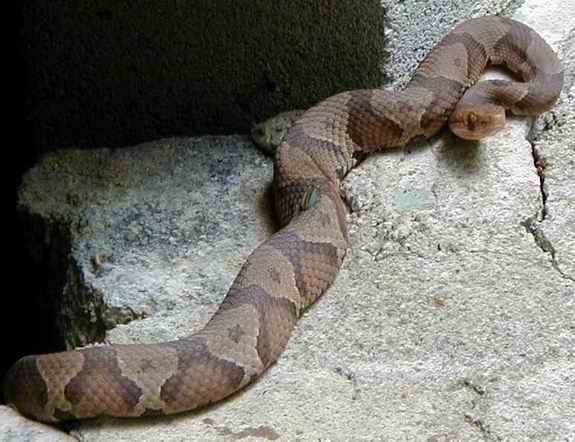|
Common Name: Copperhead, Highland Moccasin, Pilot Snake, Chunk Head Scientific Name: Agkistrodon contortrix (Generic name from the Greek Ancistron meaning fishhook, referring to the curvature of the fangs; species from the Latin contortio which means twisted [contorted] referring to the dorsal skin markings)
Copperheads are pit vipers or crotalids (family Crotalidae); poisonous snakes that are named for the two heat sensing pits used to locate prey that are positioned between the eyes and the nostrils. Their venom is hemolytic; it destroys the red corpuscles of the blood and releases the hemoglobin into the surrounding fluid. The resultant hemorrhaging destroys the snake's normal prey, mostly small mammals. Copperhead venom is mostly water with enzymatic proteins that impart the maleficent effects.
Copperheads are ovoviviparous; they bear their young live. They are also iteroparous; the female can store sperm from an autumnal breeding through the winter to ensure emergence of the brood in the more hospitable spring environment. The males seek out females by detecting female pheromones. Courtship can last for an hour and mating for up to 8 hours. During this process, the males produce a pheromone that makes the female unattractive to other males. They are gregarious, overwintering in dens call hibernacula with rattlesnakes and black rat snakes. They sometimes produce a cucumber smell when they are touched or disturbed.
Copperheads do not attack humans unless threatened. However, according to some references, copperheads are responsible for more snakebite reports in most years than any other snake. This is attributable to their ubiquity (they are the most common poisonous snake in our region), to the fact that most reports of snakebite are for those that are poisonous (harmless snake bites, though painful, are not very serious and do not generally get reported) and to the fact that the copperhead's initial reaction to a threat is to strike (rattlesnakes vibrate their tails as a warning before striking).
The copperhead bite is not serious and requires only minor medical treatment. This is because the venom of the copperhead is not as toxic as that of other poisonous snakes and because copperheads generally do not inject very much. Symptoms of snakebite vary according to individuals and according to the location of the bite. The destruction of red blood cells will almost always be accompanied by bleeding, pain and swelling, and a weak and giddy feeling. Other reported symptoms include difficulty breathing, a change in the pulse rate (usually up but sometimes down), nausea with subsequent vomiting, intestinal discomfort, and unconsciousness.
Many studies have been conducted on snakebites, all relying on reported incidents and subject to the limitations of empirical data collection and interpretation. About 4,000 to 7,000 snakebites are reported in the United States annually out of an estimated 45,000 that occur. Deaths from snakebite of any kind are rare, averaging about 10 to 15 per year. A 1954 Virginia study found that copperheads comprised 119 of the 134 snakebites reported between 1941 and 1953. A study of 400 copperhead bites found that only two incidences resulted in death, both due to simultaneous bites by 3 or more snakes. Bites occur on the extremities 95% of the time (56% on the hand) largely because about 40% of all bites occur from handling pets or attempting to capture snakes in the wild.
Polyvalent antivenin is the recommended treatment for crotalid envenomation. It is only effective if it is injected into the body within an hour of the snakebite, and even then it can just prevent continued effects not undo prior damage. Antivenin is produced by milking venom from a snake and sending it to Wyeth Ayerst Laboratories in Pennsylvania where it is used to inoculate horses from which serum is extracted that contains the antibodies that counteract the venom. Each vial of antivenin costs $150 and it takes at least 3 vials for treatment of a mild snakebite and up to 40 for a severe bite. An additional problem is that some people get sick from the antivenin due to the alien equine proteins. Because of this morbidity, particularly in children, a study that concluded in 1996 treated 55 victims including 12 children for copperhead snakebite without antivenin. Treatment resulted in no residual disability.
Snake venom has been used for medicinal purposes for millennia. It was used to treat leprosy in the 12th Century in the belief that lepers would shed their skin like snakes and it would heal. Cottonmouth venom was used to treat bleeding after tooth extraction in the United States until banned by the American Medical Association in 1940. More recently, a researcher at USC discovered that copperhead venom contains proteins that inhibit the metastasizing of cancer cells. It has also been found to contain the enzyme fibrolase, an anticoagulant that dissolves stoke inducing blood clots. |
